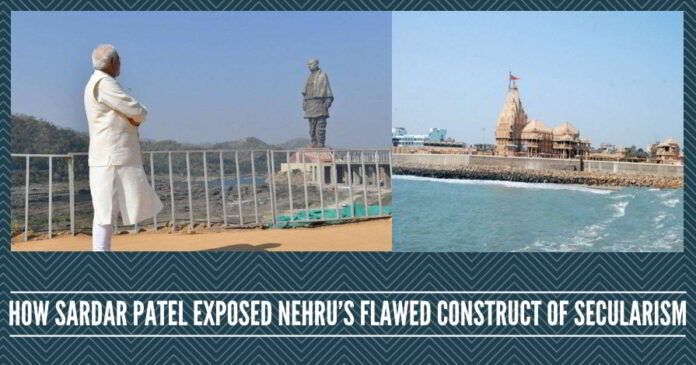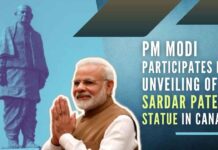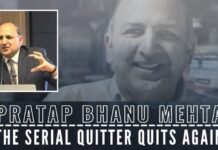
Narendra Modi had remarked after Rahul Gandhi’s visit to Somnath, that it was the same temple whose reconstruction the Congress chief’s great-grandfather had vehemently opposed.
There are two important reasons why Congressmen have been hesitant to accord Sardar Vallabhbhai Patel the position that he deserved. The first is that the Congress, steeped in the Nehru-Gandhi dynasty ideals, cannot reconcile with the fact, even more than seventy years of Independence, that Sardar Patel was more popular than Jawaharlal Nehru within the party organisation and ought to have become free India’s first Prime Minister. The second is the Iron Man of India’s refusal to accept Nehru’s version of imported secularism and insistence on understanding secularism from the country’s socio-cultural perspective. Sardar Patel could stand up to the Prime Minister not only because of his stature as a grassroots national leader but also because Nehru realised he would be on a weak wicket had he to take on the formidable politician in a direct confrontation. A good example is the issue of the reconstruction of the Somnath temple in Gujarat.
Patel secured Mahatma Gandhi’s blessings for the reconstruction, but with one condition: That the people of India, and not the Government of India, would fund the project.
The ancient Shiva temple had been ravaged by various invaders, the most notorious among them being Mahmud of Ghazni, who plundered and desecrated the temple in the early 11th century. The famed temple had been, thus, left in ruins when India gained independence. In the run-up to Partition, the temple became a symbol of both Hindu and national pride, and demands came to be raised for its restoration. The temple’s sorry state of affairs came to be increasingly considered an affront on the country’s majority population by Muslim invaders. Nehru, who is said to have once claimed that he was a Hindu by accident (not by conviction), could not have been less bothered. It was left to Sardar Patel to recognise the issue’s sensitivity — involving both national and Hindu sentiments. Barely three months after Independence, he is reported to have made known the intention to rebuild the temple on a grand scale, at a rally in Junagadh. This came after the Nawab of Junagadh had fled to Pakistan and Junagadh had dutifully acceded to the Indian Union as a result of a mix of gentle and not-so-gentle persuasion by the Sardar.
Sardar Patel thereafter stepped up his resolve on the Somnath issue. He managed to persuade the Union Cabinet to endorse the decision. He then secured Mahatma Gandhi’s blessings for the reconstruction, but with one condition: That the people of India, and not the Government of India, would fund the project. A trust was accordingly constituted for the purpose, and politician and close Patel aide KM Munshi became its chairman. Nehru was less than enthusiastic but could not place obstacles because the Mahatma had green-signalled the reconstruction. Later, after the demise of Gandhiji and Sardar Patel, it did seem for a while that the reconstruction project would be shelved. Perhaps Nehru secretly wished it to happen. But it did not.
Nehru could do little to stop the project, not just because it had the Mahatma’s blessings and the Sardar’s name attached, but also because it didn’t involve Government money.
The trust under Munshi’s guidance had already begun its work in right earnest. Besides, there were tall leaders such as Rajendra Prasad, independent India’s first President, who backed the project. Munshi, who later authored accounts of the freedom struggle, wrote in his book, Pilgrimage to Freedom, that Nehru had expressed displeasure over the ongoing issue and said he did “not like” Munshi’s effort in seeking to restore the Somnath temple because it reeked of “Hindu revivalism”. Munshi was unfazed. Rather than be defensive over the accusation of fomenting Hindu revivalism, he told the Prime Minister in writing that the “collective subconscious” of India was delighted by the reconstruction of the temple. From his association with Sardar Patel, Munshi — who was then a Minister in the Nehru Government — had acquired the courage to speak up for the larger national good and give short shrift to pseudo-secularism.
But Nehru was not done. Although he could do little to stop the project, not just because it had the Mahatma’s blessings and the Sardar’s name attached, but also because it didn’t involve Government money, he used every petty trick he could to express his petulance. When Rajendra Prasad accepted Munshi’s invite on behalf of the trust to inaugurate the reconstructed Somnath temple, Nehru wrote to the President, strongly suggesting that he abstain from the event. Nehru spoke of ‘implications’ of such an attendance but never elaborated on his fears. In any case, they were rooted in his flawed understanding of secularism in the Indian context. Rajendra Prasad ignored the advice and proceeded to inaugurate the grand temple.
In short, the Somnath temple was rebuilt in the face of stiff opposition from Nehru. If he had had his way, the ruined temple would have been handed over to the archaeology department to be maintained as it stood then — remaining a sore for the collective Indian psyche. Prime Minister Narendra Modi was, therefore, not off the mark, when he remarked after Rahul Gandhi had recently paid a visit to the Shiva shrine, that it was the same temple whose reconstruction the Congress chief’s great-grandfather had vehemently opposed.
Note:
1. The views expressed here are those of the author and do not necessarily represent or reflect the views of PGurus.











The Anti India & anti Hindu poisonous nexus between Nehru-Gandhi’s and Britain/USA + Commies/China runs deep!! The sooner this nation & Hindus understand, the better!!
Gandhi was indirect and Nehru was direct in killing the united India into fragments
nehru has got to be one incurable evil to feel a reconstruction of a mandir stinks up his nostrils. it’s really way way beyond belief that such a monster made his way to the top of the power,stepping on so many toes. it just speaks to incredible vulnerability of Indian gullible people. nowhere else in the world could such idiocy ever prevail.
Yah, very true. I am always surprised how did he make it to such a level?.
To support Hindu causes, Hindus have to shell out their money. Government money supports other religions directly. It seems that has been happening for decades. That needs to change soon if Hindus are to survive in India.
It appears that Congress under Gandhi and Nehru got a real shot in the arm after the British got their marbles shaken by Subash Chandra Bose with his INA. The British saw a great opportunity in Gandhi’s peaceful fight to freedom as a very valuable optics to make the “indomitable” British Empire to look like a nation that has taken a humanitarian consideration rather then expose their extreme fear of the imminent consequence of a violent struggle. It is only because the British had nurtured Gandhi and Nehru for their own ends that had kept them in prominence. Unlike the likes of Mangal Pandey, Bhagat Singh, Bose and many more real freedom fighters who were all killed by the British.
Why does the secular brigade hate the Hindu civilization so much? It is what makes us unique. It was and is the only continuous civilization where the religion practiced 5000 years ago is still visible and lived.
Dear Sir
Chacha was never secular ,this we learnt from the various incidents in the past. Somnath Temple reconstruction is one of them.He had a body of India and heart of Gazni.
The Mahatma was a Hindu Faker, Nehru was a Total Amoral Fake and which one of the two is the Most Despicable Indian to have lived in the 2000s should be debated.